Stan C. Smith's Blog, page 36
February 13, 2017
Progress Report on PROFUSION
 Many readers have asked when the next book in the Diffusion series will be available. I do not have a definite date yet, but I can tell you the book is now halfway complete. I hope to finish it before the snow geese have all passed through on their migration north (April). To say that I'm excited about Profusion would be an understatement. If you have read Diffusion and Infusion, you may be wondering where things are headed. Well, I can tell you the stakes are getting even higher. The Lamotelokhai is a wondrous entity, but it is NOT to be used carelessly! The results of its misuse can be mind-boggling and terrifying.
Many readers have asked when the next book in the Diffusion series will be available. I do not have a definite date yet, but I can tell you the book is now halfway complete. I hope to finish it before the snow geese have all passed through on their migration north (April). To say that I'm excited about Profusion would be an understatement. If you have read Diffusion and Infusion, you may be wondering where things are headed. Well, I can tell you the stakes are getting even higher. The Lamotelokhai is a wondrous entity, but it is NOT to be used carelessly! The results of its misuse can be mind-boggling and terrifying.As I'm sure you can guess, tree kangaroos play a significant role in Profusion.
The term PROFUSION refers to the "pouring forth" of something in great quantity. The question is, what exactly is it that will be pouring forth?
I hope to have the book ready for advance readers in the next few months. This is something I will be requesting help with, so stay tuned.
Published on February 13, 2017 16:04
Why you should read Robert McCammon
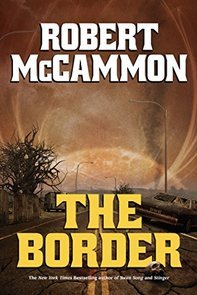 I am currently reading Robert McCammon's The Border. If you like post-apocalyptic tales, and you are hungry for an original premise, this book might satisfy that hunger. Imagine our planet just happens to be at the front lines (the border) of a massive war between two advanced alien species. They have nothing against humans, just as I have nothing against the colony of ants that happens to be located where I'm going to build a shed in my backyard. I don't give much thought to the ants, but it doesn't go so well for them as I start clearing the ground.
I am currently reading Robert McCammon's The Border. If you like post-apocalyptic tales, and you are hungry for an original premise, this book might satisfy that hunger. Imagine our planet just happens to be at the front lines (the border) of a massive war between two advanced alien species. They have nothing against humans, just as I have nothing against the colony of ants that happens to be located where I'm going to build a shed in my backyard. I don't give much thought to the ants, but it doesn't go so well for them as I start clearing the ground.McCammon is well known for writing critically acclaimed horror novels in the 80s and early 90s. In fact, several of his award-winning books were the amazing post-apocalyptic novels, Stinger and Swan Song, to which The Border will inevitably be compared. But McCammon's more recent writing shows an expansion into much broader themes.
My introduction to McCammon's work was Boy's Life, a beautiful, gritty coming of age story of a boy trying to discover who killed a man that his father attempted to rescue, before the incident drives his father to insanity. The magic that dwells within the mind of every 12-year-old boy comes to life in this story, and it unfolds against the backdrop of racial inequality of the deep south (U.S.) of the 1960s. Wonderful story!
Perhaps the most stunning departure from McCammon's horror heritage is a series of historical mystery novels (with just a slight twist of the supernatural at times) about Matthew Corbett, a kind of self-made investigator in the late 17th century. The first book, Speaks the Nightbird, focuses primarily on a trial of a woman accused of witchcraft. I highly recommend the entire series.
And for one more major departure from his roots, in 2011 McCammon published The Five. This is a novel about a struggling, hard-working rock band on their last tour together. It is beautifully written (I would call it poetic) and is filled with subtle references to much of the same music I have listened to since I was a teen. It is McCammon's love letter to rock-n-roll, and I just wish I could have been the one to write it.
If you are a McCammon fan, great! If you haven't tried him yet, I hope this gives you ideas for which books might be most suitable as an introduction to his work.
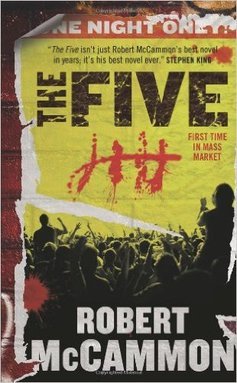
Published on February 13, 2017 15:57
February is not so bad
To most North Americans, February is a tedious month. They are tired of winter by this point, and it is too early for signs of spring. But I love February. One reason why is I'm fascinated by waterfowl. In my area I can witness one of the great animal migrations of this planet, the northern migration of snow geese. They fly over by the hundreds of thousands and cover our cut corn and soybean fields with vast, white blankets of gabbling geese. If you've read any of my books, you know I'm enthralled by nature, which is why creatures and wilderness environments are so important in my stories.

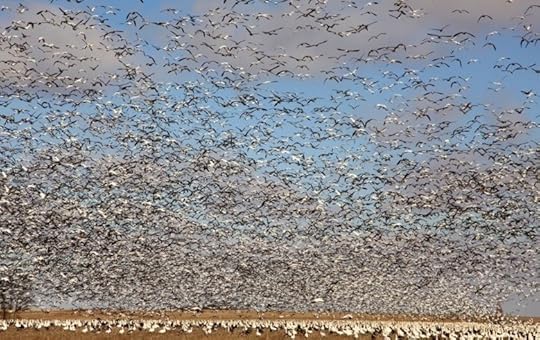


Published on February 13, 2017 15:49
December 29, 2016
I love good reviews!
Got another great review of Diffusion the other day.
This reader is correct... if you like captivating twists and turns that are "confoundingly extraordinary," then you should read the Diffusion novels.
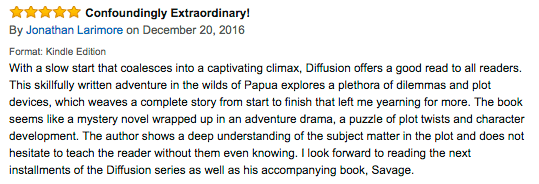
This reader is correct... if you like captivating twists and turns that are "confoundingly extraordinary," then you should read the Diffusion novels.

Published on December 29, 2016 17:38
December 6, 2016
I'd like to give you a free copy of my first novel, Diffusion.
If you have not read my first novel, Diffusion, here is a chance to get a free ebook copy. Do you like action and adventure stories? Do you like surprising and mysterious twists and turns? If so, I am confident you will enjoy Diffusion!
Excerpt from the most recent review on Amazon:
"I usually don't read science fiction or fantasy, but I almost swallowed these whole and can't wait to see what happens next. I've loaned them out to my colleagues and they love them too. Bravo, Mr. Smith!"
If you want to grab a free copy of Diffusion, tap or click the link below. It will ask you to enter your name and email address, and then you choose the format you want (formats available for all tablets, computers, and ebook readers). It will email your book immediately, along with instructions to get it onto your device.
Have you already read Diffusion? Feel free to share this with friends you think might want to read it! This is an instaFreebie giveaway. #instafreebie
Happy reading!
YES! GIVE ME MY FREE BOOK!
Excerpt from the most recent review on Amazon:
"I usually don't read science fiction or fantasy, but I almost swallowed these whole and can't wait to see what happens next. I've loaned them out to my colleagues and they love them too. Bravo, Mr. Smith!"
If you want to grab a free copy of Diffusion, tap or click the link below. It will ask you to enter your name and email address, and then you choose the format you want (formats available for all tablets, computers, and ebook readers). It will email your book immediately, along with instructions to get it onto your device.
Have you already read Diffusion? Feel free to share this with friends you think might want to read it! This is an instaFreebie giveaway. #instafreebie
Happy reading!
YES! GIVE ME MY FREE BOOK!
Published on December 06, 2016 05:32
September 28, 2016
Alfred Wallace - A man who should be known, but isn’t
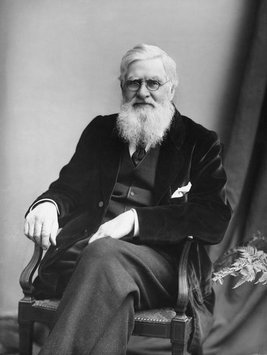 Can you imagine what it must have been like to visit the tropical islands of the Dutch East Indies in the mid-1800s? Today we can fly to various tropical destinations, stay in plush resorts, and safely visit natural wonders with the help of English-speaking guides. Things were different 160 years ago, when the scientist Alfred Wallace journeyed to the Malay Archipelago and spent eight years collecting more than 100,000 insects, birds, and other animals, which he donated to British museums. Wallace wrote an amazing two-volume book describing his experiences. The book is titled "The Malay Archipelago," and you can get various ebook and print versions of it on Amazon and elsewhere (some of them are even free). I highly recommend this book. It is an eye-opening experience, and it may change the way you look at human nature. Although Wallace bore the Eurocentric prejudices typical of his time, he was an acute observer of native cultures and had the ability to recognize features of tribal life that were in some ways more admirable than his own “modern” society. He also nearly died numerous times from sickness, accidents, and violence.
Can you imagine what it must have been like to visit the tropical islands of the Dutch East Indies in the mid-1800s? Today we can fly to various tropical destinations, stay in plush resorts, and safely visit natural wonders with the help of English-speaking guides. Things were different 160 years ago, when the scientist Alfred Wallace journeyed to the Malay Archipelago and spent eight years collecting more than 100,000 insects, birds, and other animals, which he donated to British museums. Wallace wrote an amazing two-volume book describing his experiences. The book is titled "The Malay Archipelago," and you can get various ebook and print versions of it on Amazon and elsewhere (some of them are even free). I highly recommend this book. It is an eye-opening experience, and it may change the way you look at human nature. Although Wallace bore the Eurocentric prejudices typical of his time, he was an acute observer of native cultures and had the ability to recognize features of tribal life that were in some ways more admirable than his own “modern” society. He also nearly died numerous times from sickness, accidents, and violence.Here’s the real kicker. During his travels, Wallace came up with the idea that living things evolve as they adapt to their environment. He did this independently from the famous Charles Darwin. Although Wallace had contemplated the idea for several years, the final clarifying details of it came to him when he was sick with fever on the island of Halmahera in 1858. He wrote a brief paper on it and sent it to Charles Darwin to review. Darwin had come up with the same theory, and this inspired him to act. The two men published a joint paper on it in 1858. They were friends, not rivals. A year later, Darwin wrote and published his book, "On the Origin of Species." This book made him famous, and Wallace faded to relative obscurity.
Samuel Inwood, the main character in my new novel, Savage, is patterned after Alfred Wallace. In fact, Samuel was so inspired by Wallace’s journey that he embarked on his own expedition to New Guinea in 1868. As you can guess, things don’t go so well for Samuel. Not only is he forced to endure unthinkable hardships, he is compelled to reconsider what it means to be civilized.
Is Samuel a civilized man, or is he a savage? After you read the book, I’d love to hear your thoughts on this.
Published on September 28, 2016 08:21
September 7, 2016
The most satisfying moment

 There are many satisfying moments during the process of writing a novel. Each time you finish a chapter, for example. And when you finish the first complete draft. Or when you finally finish that fifteenth editing run-through and realize the story is about ready. But nothing can compare to that moment when the proof copy of the printed version of the book arrives in the mail and you hold it in your hands for the first time. Maybe it’s the book’s heft, or the glossy cover, or the smell of the pages. Or maybe it’s the countless hours of work it took to get to this point.
There are many satisfying moments during the process of writing a novel. Each time you finish a chapter, for example. And when you finish the first complete draft. Or when you finally finish that fifteenth editing run-through and realize the story is about ready. But nothing can compare to that moment when the proof copy of the printed version of the book arrives in the mail and you hold it in your hands for the first time. Maybe it’s the book’s heft, or the glossy cover, or the smell of the pages. Or maybe it’s the countless hours of work it took to get to this point.The cover image looks a little dark to me, but that tends to happen when you look at a printed version versus the digital on-screen version. So I am happy with it and will go ahead and approve it. The Kindle version of SAVAGE is already available, but the print version should show up on Amazon within a few days.
Now its time to take a brief break by working for ten days at the Kansas State Fair (at the Original Beer Garden… stop by and say hello if you happen to be there), and then back to working on my next novel. It is tentatively titled PROFUSION and is the third novel in the Diffusion series.
Amazon Author page: http://goo.gl/rojJEA
Published on September 07, 2016 10:00
June 26, 2016
An Unlikely Bird - The Cassowary
 Another creature that plays an important role in my upcoming novel, SAVAGE (as well as the title role in my short story, BLUE ARROW) is the Cassowary. The Eastern Turkey is possibly the most impressive bird you’ll see in Missouri. When you see one, you think, “Cool, a turkey.” But when you lay eyes on a cassowary, you think, “Holy !$*#!, it’s a dinosaur!” The cassowary is the second heaviest bird (the Ostrich is first), and they live in New Guinea, its surrounding islands, and northern Australia. Trish and I were lucky enough to see a cassowary while on a rainforest hike in Queensland, Australia. We took video of it, but we could never show that video to our students because Trish, who was holding the camera, kept exclaiming, “Oh, Sh**! Oh, sh**! It’s a cassowary!” Yeah, it’s that exciting to see one.
Another creature that plays an important role in my upcoming novel, SAVAGE (as well as the title role in my short story, BLUE ARROW) is the Cassowary. The Eastern Turkey is possibly the most impressive bird you’ll see in Missouri. When you see one, you think, “Cool, a turkey.” But when you lay eyes on a cassowary, you think, “Holy !$*#!, it’s a dinosaur!” The cassowary is the second heaviest bird (the Ostrich is first), and they live in New Guinea, its surrounding islands, and northern Australia. Trish and I were lucky enough to see a cassowary while on a rainforest hike in Queensland, Australia. We took video of it, but we could never show that video to our students because Trish, who was holding the camera, kept exclaiming, “Oh, Sh**! Oh, sh**! It’s a cassowary!” Yeah, it’s that exciting to see one. These birds, which are about five feet tall and weigh up to 130 pounds, have a reputation for being aggressive (although, as usual, people’s opinions about this are exaggerated). When we would hike in areas where they lived, warning signs were posted at trailheads, and brochures about them were readily available. When Australians describe the dangers of cassowaries, they are fond of using the word “disembowel.” An unpleasant word, by any measure, but a cassowary has very sharp claws on its three dinosaur-like toes that are capable of doing some damage. Cassowaries, have a large, bony helmet, or casque, growing from the top of the head, but no one is quite sure of its function. Researchers have suggested it is used as a battering ram to protect the head as the bird runs through the thick tropical forest at up to 31 mph. Regardless, cassowaries are the most bone-headed birds I know of. Cassowaries can also jump 7 feet straight up, and they can swim wide rivers! Impressive, huh?
So the Cassowary is another animal deserving of the BAHF, and this time it stands for the “Bosker Animal Hall of Fame.”
Fun Fact: Bosker is another Australian and New Zealand slang adjective, which also means “Awesome.”
Published on June 26, 2016 13:35
June 22, 2016
An Unlikely Creature - The Tree Kangaroo
Published on June 22, 2016 16:58
March 2, 2016
A Great Review of Diffusion
 If you have not yet read Diffusion (or even if you have), below is a wonderful review that was recently posted to Goodreads. This reviewer did an excellent job of capturing the overall essence of the novel. By the way, if you have read Diffusion or Infusion, it would be great if you could post reviews on their Amazon product pages!
If you have not yet read Diffusion (or even if you have), below is a wonderful review that was recently posted to Goodreads. This reviewer did an excellent job of capturing the overall essence of the novel. By the way, if you have read Diffusion or Infusion, it would be great if you could post reviews on their Amazon product pages!Here is the recent review:
"Some spoilers below...Read with caution!
This was a fascinating book by first-time-published author, Stan Smith. What I particularly enjoyed was how quickly the book introduces action and conflict; this makes for a story that is riveting and engaging.
The setting of the book is different from a lot of books I've read lately, and I loved learning about Papua and the impact of anthropology and diffusion. What costs come with our interactions with other cultures? When we visit another country and civilization, is it only for our own needs? What happens when we make assumptions of those with beliefs and practices different than ours?
Smith explores these questions using elements of science fiction that I found to be unique and interesting. Using science fiction to investigate and address real-life issues is just one of the many ways that this book transcends multiple genres. Quentin, his family, and a small group of students start out as relatively naive characters with the goal of exploring another culture. After a mysterious plane crash, the characters quickly learn that their assumptions, mindsets, and previous ways of living must be discarded in order to try to understand their new situation and to adapt to their surroundings. Their arrival in this unfamiliar territory is devastating not only for themselves, but also for the tribe they encounter.
In this novel, the "end of the world" is presented in many ways: the death of loved ones, the end of a culture, the end of previous ways of living, the end of one's previously formed identity, the literal ending of the world, and more. The novel is not an apocalyptic novel, but it certain has some of those influences. The end of the world is something that many of the characters express, especially those from the tribe. They are aware of this (and have been expecting it for quite some time), while Quentin and the others struggle with trying to understand and shed their preconceived notions of the world and beyond.
This inability to "let go" and to be more open-minded is also represented in the fate of Quentin's son, and it causes many fatal problems for all the characters. Those from the tribe warned Quentin and his wife about Addison, but they refused to believe them until it was far too late. Even Samuel, a character who has been with this tribe for a couple hundred years, still fails to see that he is the one who is a relic of a closed-minded and damaging culture; he may see himself as progressive, but that is hardly the case.
What I've mentioned above is just a little piece of Diffusion; this creative and fast-paced novel is sure to fascinate many readers. I'm looking forward to reading the next installment in this series!"
--reviewed by Megan McCormack
Published on March 02, 2016 16:51


 Since a tree kangaroo has an important role in my upcoming novel, Savage, as well as in my novels, Diffusion and Infusion, I thought I would expound upon this creature’s awesomeness. Yes, tree kangaroos are real! They live on the island of New Guinea, but also in very northern Australia and some of the Indonesian islands. Why are tree kangaroos so cool? Well, because they’re kangaroos—that live in trees! When Australian Aborigines and Papuan (New Guinea) natives told early European explorers about tree kangaroos, the explorers refused to believe the stories. You have to admit it seems pretty unlikely, right? These creatures eat, sleep, and breed in the treetops, but that doesn’t mean they live a comfortable existence. First of all, I imagine breeding in the treetops requires some caution (yikes!). Second, they seem to be a tasty meal for their primary predator, the amethystine python (which have a habit of hugging much too tightly). Third, natives hunt them for food (In New Guinea, "the man who has successfully hunted a tree-kangaroo has greatness bestowed upon him. He has conquered the largest, most prestigious and human-like marsupial known to his people." [Tim Flannery, from the awesome book, Throwim Way Leg]). And fourth, they depend on pristine rainforest, and if you haven’t heard, rainforests are getting smaller every day (a real bummer).
Since a tree kangaroo has an important role in my upcoming novel, Savage, as well as in my novels, Diffusion and Infusion, I thought I would expound upon this creature’s awesomeness. Yes, tree kangaroos are real! They live on the island of New Guinea, but also in very northern Australia and some of the Indonesian islands. Why are tree kangaroos so cool? Well, because they’re kangaroos—that live in trees! When Australian Aborigines and Papuan (New Guinea) natives told early European explorers about tree kangaroos, the explorers refused to believe the stories. You have to admit it seems pretty unlikely, right? These creatures eat, sleep, and breed in the treetops, but that doesn’t mean they live a comfortable existence. First of all, I imagine breeding in the treetops requires some caution (yikes!). Second, they seem to be a tasty meal for their primary predator, the amethystine python (which have a habit of hugging much too tightly). Third, natives hunt them for food (In New Guinea, "the man who has successfully hunted a tree-kangaroo has greatness bestowed upon him. He has conquered the largest, most prestigious and human-like marsupial known to his people." [Tim Flannery, from the awesome book, Throwim Way Leg]). And fourth, they depend on pristine rainforest, and if you haven’t heard, rainforests are getting smaller every day (a real bummer).

